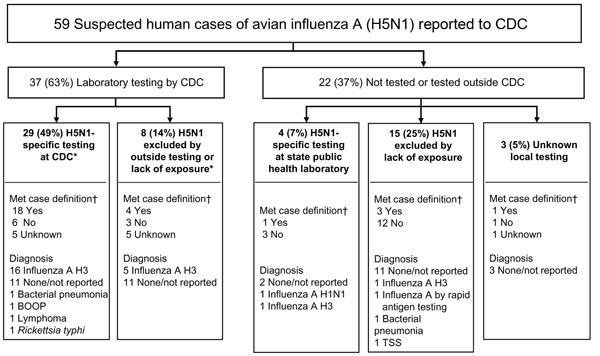Volume 13, Number 2—February 2007
Dispatch
No Evidence of Avian Influenza A H5N1 among Returning US Travelers
Figure

Figure. Influenza testing of suspected US cases of avian influenza A H5N1 reported to the Centers for Disease Control and Prevention (CDC) from February 2003 through May 2006. *Of the 37 samples tested by CDC, 35 were respiratory samples, 1 was serum, and 1 was a lung specimen. All 35 respiratory samples received by CDC were tested for human influenza by reverse transcription–PCR, and the serum sample was tested by microneutralization assay. †CDC suspected H5N1 case definition, February 2, 2004–June 7, 2006 (6): a patient is hospitalized and has radiographically confirmed pneumonia, acute respiratory distress syndrome, or other severe respiratory illness for which an alternate diagnosis has not been established; and the patient has a history of travel within 10 days of symptom onset to a country with documented H5N1 avian influenza in poultry and/or humans; or a patient is hospitalized or ambulatory and has a documented temperature >38°C (>100.4°F); and has a cough, sore throat, or shortness of breath; and has a history of contact with domestic poultry or a patient with known or suspected H5N1 case in an H5N1-affected country <10 days of symptom onset. BOOP, bronchiolitis and obliterans organizing pneumonia; TSS, toxic shock syndrome.
References
- World Organization for Animal Health (OIE). Update on avian influenza in animals (type H5). 2006. [cited 2006 Nov 4]. Available from http://www.oie.int/downld/AVIAN%20INFLUENZA/A_AI-Asia.htm
- World Health Organization. Confirmed human cases of avian influenza A(H5N1). 2006. [cited 2006 Nov 4]. Available from http://www.who.int/csr/disease/avian_influenza/country/en/index.html
- Areechokchai D, Jiraphongsa C, Laosiritaworn Y, Hanshaoworakul W, O’Reilly M. Investigation of avian influenza (H5N1) outbreak in humans—Thailand, 2004.MMWR Morb Mortal Wkly Rep. 2006;55(Suppl 1):3–6.PubMedGoogle Scholar
- Dinh PN, Long HT, Tien NTK, Hien NT, Mai LTQ, Phong LH, Risk factors for human infection with avian influenza A H5N1, Vietnam, 2004.Emerg Infect Dis. 2006;12:1841–7.PubMedGoogle Scholar
- Centers for Disease Control and Prevention. Update: influenza activity—United States and worldwide, 2002–03 season, and composition of the 2003–04 influenza vaccine.MMWR Morb Mortal Wkly Rep. 2003;52:516–21.PubMedGoogle Scholar
- Centers for Disease Control and Prevention. Update on influenza A(H5N1) and SARS: interim recommendations for enhanced U.S. surveillance, testing, and infection controls. 2004 [cited 2006 Nov 4]. Available from http://www.cdc.gov/flu/avian/professional/han020302.htm
- Rowe T, Abernathy RA, Hu-Primmer J, Thompson WW, Lu X, Lim W, Detection of antibody to avian influenza A (H5N1) virus in human serum by using a combination of serologic assays.J Clin Microbiol. 1999;37:937–43.PubMedGoogle Scholar
- World Health Organization. Recommended laboratory tests to identify avian influenza A virus in specimens from humans. 2005. [cited 2006 Jan 26]. Available from http://www.who.int/csr/disease/avian_influenza/guidelines/avian_labtests2.pdf
- Vong S, Coghlan B, Mardy S, Holl D, Seng H, Ly S, Low frequency of poultry-to-human H5N1 virus transmission, southern Cambodia.Emerg Infect Dis. 2006;12:1542–7.PubMedGoogle Scholar
- Wang M, Di B, Zhou D-H, Zheng B-J, Jing H, Lin Y-P, Food markets with live birds as source of avian influenza.Emerg Infect Dis. 2006;12:1773–5.PubMedGoogle Scholar
- Shek LP, Lee BW. Epidemiology and seasonality of respiratory tract virus infections in the tropics.Paediatr Respir Rev. 2003;4:105–11. DOIPubMedGoogle Scholar
- Mutsch M, Tavernini M, Marx A, Gregory V, Lin YP, Hay AJ, Influenza virus infection in travelers to tropical and subtropical countries.Clin Infect Dis. 2005;40:1282–7. DOIPubMedGoogle Scholar
- Wong CM, Yang L, Chan KP, Leung GM, Chan KH, Guan Y, Influenza-associated hospitalization in a subtropical city.PLoS Med. 2006;3:e121. DOIPubMedGoogle Scholar
- Smith NM, Bresee JS, Shay DK, Uyeki TM, Cox NJ, Strikas RA. Prevention and control of influenza: recommendations of the Advisory Committee on Immunization Practices (ACIP).MMWR Recomm Rep. 2006;55:1–42.PubMedGoogle Scholar
- World Health Organization. WHO case definitions for human infections with influenza A(H5N1) virus. 2006. [cited 2006 Aug 30]. Available from http://www.who.int/csr/disease/avian_influenza/guidelines/case_definition2006_08_29/en/index.html
- Centers for Disease Control and Prevention. Updated interim guidance for laboratory testing of persons with suspected infection with avian influenza A (H5N1) virus in the United States. 2006. [cited 2006 Nov 4]. Available from http://www2a.cdc.gov/han/ArchiveSys/ViewMsgV.asp?AlertNum=00246